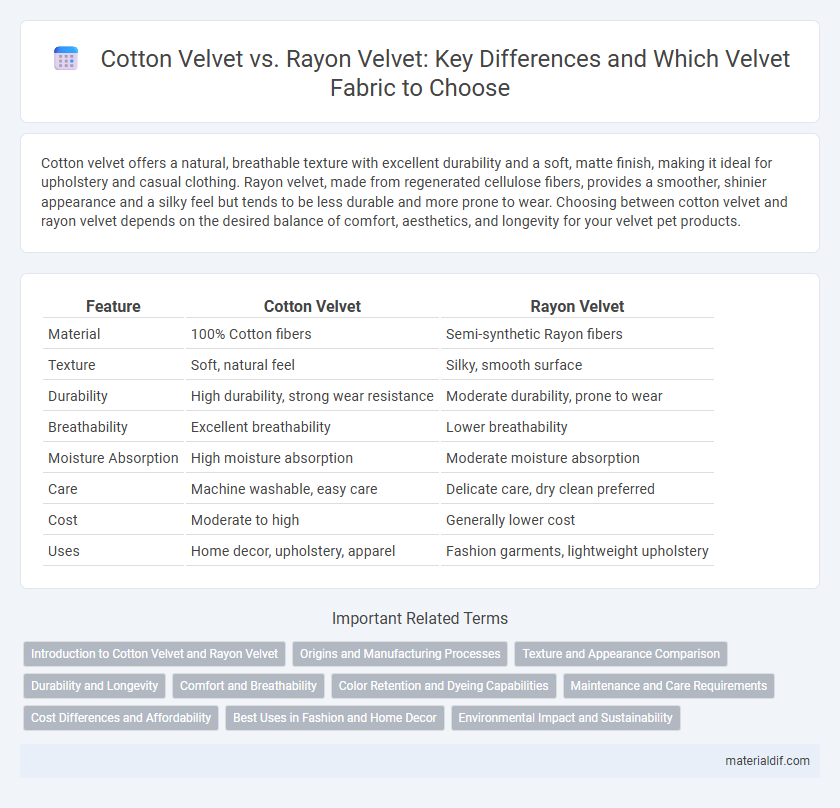Cotton velvet offers a natural, breathable texture with excellent durability and a soft, matte finish, making it ideal for upholstery and casual clothing. Rayon velvet, made from regenerated cellulose fibers, provides a smoother, shinier appearance and a silky feel but tends to be less durable and more prone to wear. Choosing between cotton velvet and rayon velvet depends on the desired balance of comfort, aesthetics, and longevity for your velvet pet products.
Table of Comparison
| Feature | Cotton Velvet | Rayon Velvet |
|---|---|---|
| Material | 100% Cotton fibers | Semi-synthetic Rayon fibers |
| Texture | Soft, natural feel | Silky, smooth surface |
| Durability | High durability, strong wear resistance | Moderate durability, prone to wear |
| Breathability | Excellent breathability | Lower breathability |
| Moisture Absorption | High moisture absorption | Moderate moisture absorption |
| Care | Machine washable, easy care | Delicate care, dry clean preferred |
| Cost | Moderate to high | Generally lower cost |
| Uses | Home decor, upholstery, apparel | Fashion garments, lightweight upholstery |
Introduction to Cotton Velvet and Rayon Velvet
Cotton velvet is a natural fiber fabric known for its softness, breathability, and durability, often used in upholstery and apparel for a comfortable, luxurious feel. Rayon velvet, made from regenerated cellulose fibers, offers a silky sheen and smooth texture with excellent drape, making it popular in fashion and decorative textiles. Both fabrics have unique qualities that cater to different aesthetic and functional preferences in velvet applications.
Origins and Manufacturing Processes
Cotton velvet originates from natural cotton fibers spun into yarn and woven on traditional looms, offering breathability and durability, while rayon velvet is made from regenerated cellulose fibers derived from wood pulp through chemical processes. Cotton velvet's manufacturing involves carding, spinning, and weaving with cotton yarns, producing a soft texture with natural moisture absorption. Rayon velvet undergoes a more complex production including dissolving cellulose, extruding fibers, and weaving, resulting in a fabric with a silk-like sheen but less breathability compared to cotton velvet.
Texture and Appearance Comparison
Cotton velvet features a soft, matte texture with a natural, breathable feel, while rayon velvet offers a smoother, silkier surface with a subtle sheen that enhances its luxurious appearance. Cotton velvet's texture is denser and more durable, often exhibiting a slightly plush nap, whereas rayon velvet provides a lighter, more fluid drape with a finer pile. The visual richness of rayon velvet suits elegant apparel and upholstery, contrasting with cotton velvet's classic, cozy aesthetic ideal for casual and rustic designs.
Durability and Longevity
Cotton velvet offers superior durability and longevity compared to rayon velvet due to its natural fiber composition, which resists wear and tear more effectively. Rayon velvet, while softer and more affordable, tends to show signs of pilling and fading sooner under frequent use and washing. For long-lasting upholstery or garments, cotton velvet is the preferred choice for maintaining its texture and appearance over time.
Comfort and Breathability
Cotton velvet offers superior breathability and natural moisture-wicking properties, making it more comfortable for extended wear in warm climates. Rayon velvet, while softer and silkier to the touch, tends to retain heat and moisture, which can reduce overall comfort. Choosing cotton velvet enhances airflow and reduces sweating, ideal for garments needing both luxury and practicality.
Color Retention and Dyeing Capabilities
Cotton velvet exhibits superior color retention due to its natural fiber structure, allowing dyes to bind more effectively and maintain vibrancy after multiple washes. Rayon velvet offers high dye absorption with a wide range of color options, but its synthetic composition can lead to faster fading over time. For long-lasting, rich colors, cotton velvet is generally preferred, while rayon velvet provides greater initial color variety and softness.
Maintenance and Care Requirements
Cotton velvet requires gentle washing with mild detergents and should be air-dried to maintain its softness and prevent shrinkage, making it suitable for low-maintenance care routines. Rayon velvet, being more delicate, demands dry cleaning or very careful hand washing to avoid fiber damage and preserve its smooth texture. Proper storage away from direct sunlight is essential for both fabrics to prevent fading and maintain their luxurious appearance.
Cost Differences and Affordability
Cotton velvet typically costs more than rayon velvet due to its natural fibers and durability, making it a premium choice for upholstery and apparel. Rayon velvet offers a more affordable alternative with a softer feel but may lack the longevity of cotton velvet. Budget-conscious buyers often prefer rayon velvet for its cost-effectiveness without compromising too much on texture and appearance.
Best Uses in Fashion and Home Decor
Cotton velvet offers durability and breathability, making it ideal for casual fashion pieces and cozy home decor like upholstery and curtains, while rayon velvet provides a luxurious sheen and softness, perfect for elegant eveningwear and decorative pillows. Cotton velvet's natural fibers excel in warm-weather clothing and sturdy furnishings, whereas rayon velvet's smooth texture suits formal attire and statement decor accents. Choosing between them depends on the desired combination of comfort, appearance, and application in both fashion and interior design.
Environmental Impact and Sustainability
Cotton velvet, derived from natural cotton fibers, offers a more sustainable option due to its biodegradability and lower chemical processing compared to rayon velvet, which is made from chemically treated cellulose. Although cotton cultivation requires significant water and land resources, organic and sustainably farmed cotton can reduce its environmental footprint, whereas rayon production often involves toxic solvents and deforestation concerns due to sourcing from wood pulp. Choosing cotton velvet supports renewable agriculture and reduces synthetic chemical use, positioning it as the eco-friendlier choice in velvet textiles.
Cotton Velvet vs Rayon Velvet Infographic

 materialdif.com
materialdif.com